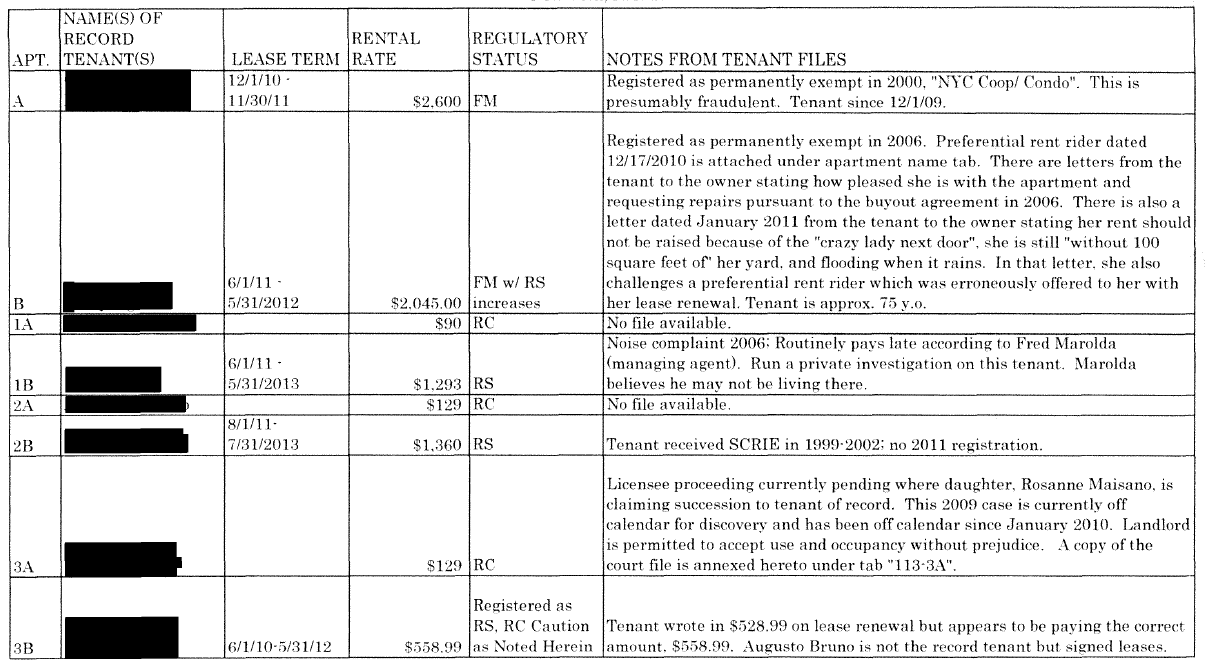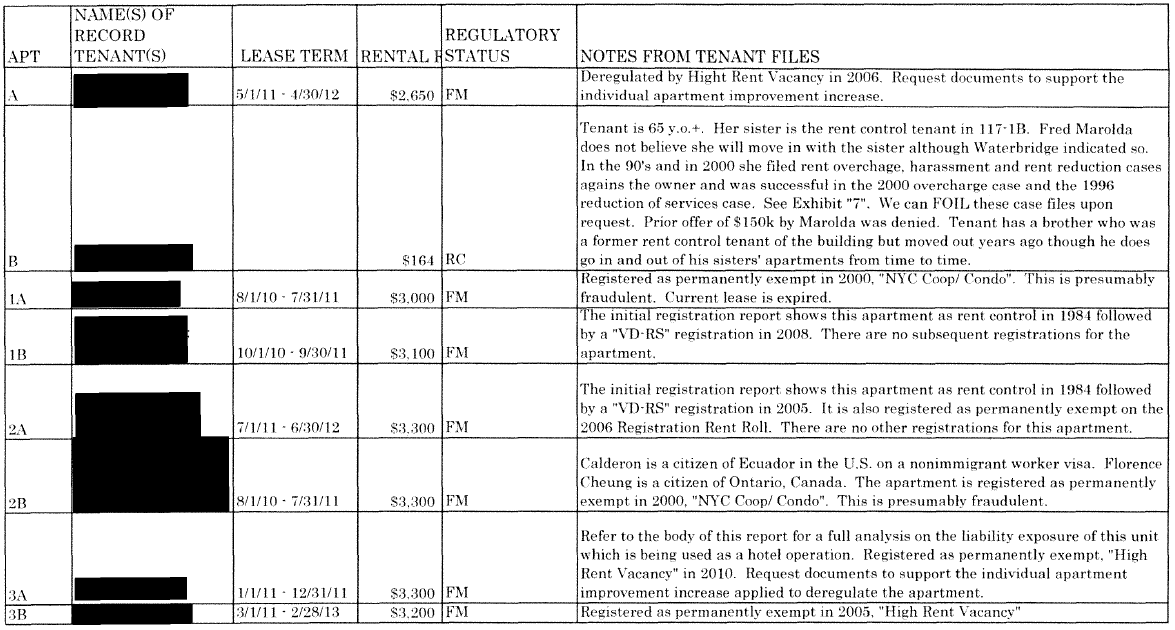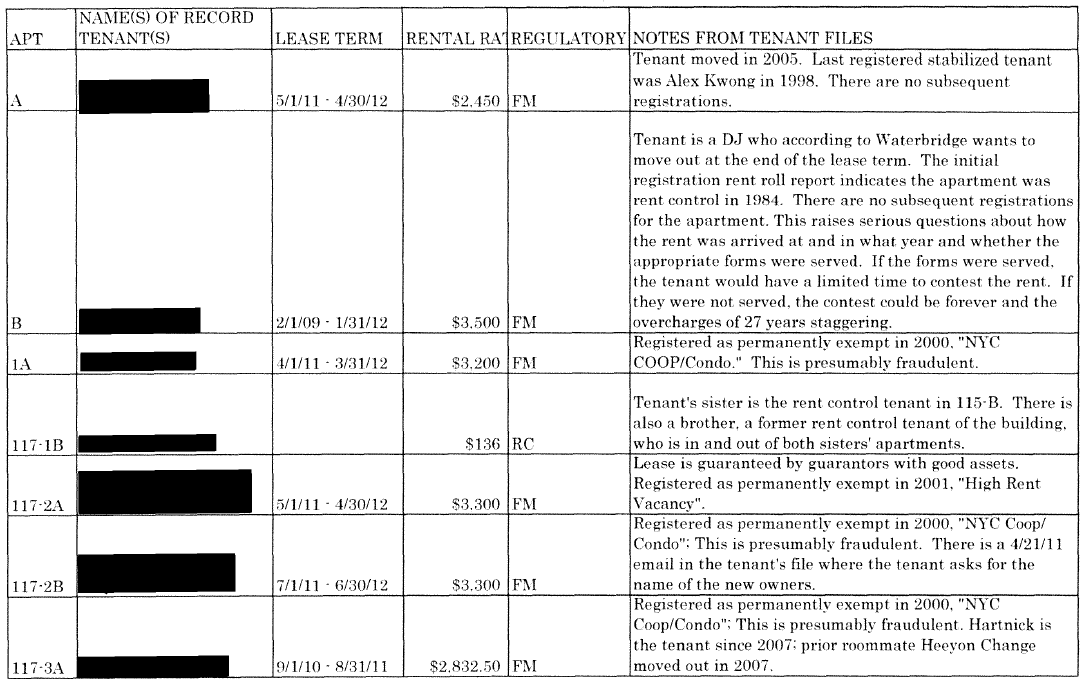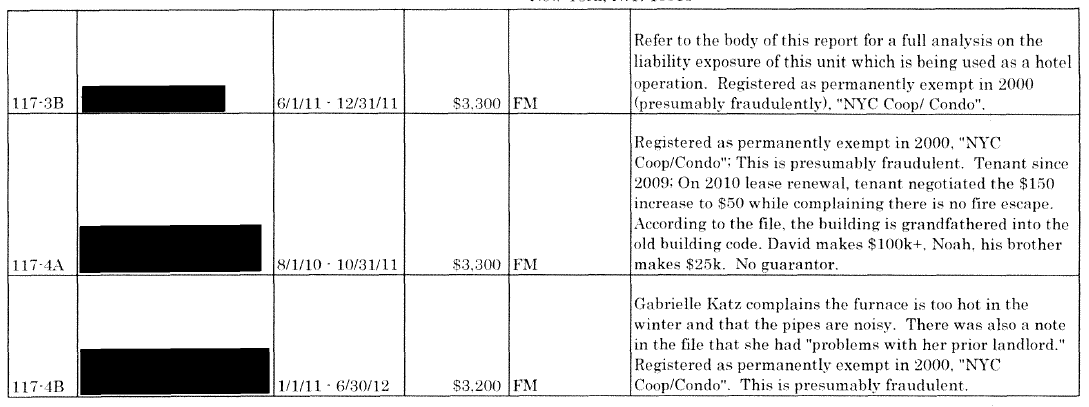Adam Leitman Bailey Due Diligence Report 5
DUE DILIGENCE REPORT
Prepared By
Adam Leitman Bailey, P.C.
120 Broadway, Seventeenth Floor
New York, New York 10271
(212) 825-0365
alblawfirm.com
August 5th, 2011
EXECUTIVE SUMMARY
While it is always the firm’s client’s business decision whether or not to go ahead with purchases of buildings and the firm do not directly advise on the prudence of any given purchase, this study reveals several unusually high legal risk factors associated with ownership of these buildings.
INTRODUCTION
This due diligence report includes the firm’s research findings and the rent regulatory status of each of the residential units of [redacted] and [redacted], New York, N.Y..
The firm’s due diligence investigation included an analysis of how each free market apartment was deregulated and this report advises on the owner’s risks and liability with respect to deregulation of the apartments.
The firm’s research also includes a review of the status of any open violations issued against the building by the Department of Housing Preservation and Development of the City of New York and the New York City Department of Buildings.
The firm also searched the files of the Supreme Court of the State of New York, New York County, the Civil Court of the City of New York and the Housing Court of the City of New York for pending litigation with respect to this building.
The firm’s investigations have produced the following results.
Rent Regulatory Status of the Property’s Residential Units
The property is composed of three separate buildings each holding its own block and lot as enumerated above. Each building consists of ten residential units spread over five stories. The current, actual use of all but two of the apartments (115-3A & 117-3B (“the hotel apartments”» appear to be consistent with the Certificates of Occupancy for the buildings. A copy of each of the Certificates of Occupancy are annexed hereto as Exhibit “I” for your ready reference.
The seller’s managing agent provided its current rent roll reports and on August 2, 2011, allowed a full business day’s access to their tenant files. Unsurprisingly, the seller’s managing agent was not wholly cooperative with our desire to make copies of its tenant files. However, on several occasions, the firm was able to copy certain, selected documents from the files and for each apartment, the firm took notes based on the firm’s review of the files. The firm’s findings from the review of the tenant’s files are provided herein. The documents the firm copied from the tenant files are annexed hereto under exhibit tabs labeled by unit number.
Annexed hereto as Exhibits “2”, “3” and “4” are certified Division of Housing and Community Renewal Registration Rent Roll Reports for each of the three buildings, respectively.
Out of the thirty residential units on the property, there are six rent-controlled apartments, two rent-stabilized apartments and twenty free market apartments. The two unaccounted for apartments are Apartments 113″3B [redacted] and 113″B ([redacted]).
[redacted] tenancy may be subject to rent control if he succeeded to a tenant who moved into the apartment prior to 1971. The tenant file did not indicate when his tenancy commenced but [redacted] investigation found that he is a “younger tenant” which gives rise to the possibility that he may have succeeded to an older relative. The initial registration for this building in 1984 shows [redacted] as the registered tenant and designates this unit as rent stabilized with a then legal rent of $160.09 and no lease commencement date. The current legal-regulated rent is $558.99 though the current owner has not filed its registration with DHCR as of August 2, 2011. Notably, one [redacted] signed the current, fully executed lease renewal although he is not a record tenant.
[redacted] is the current record tenant of Apartment 113″ B. She moved into the apartment on or around March 8 2006, from her presumably rent-stabilized, second-floor apartment at [redacted] New York, N.Y., and pursuant to a buyout agreement the owner of 145 [redacted], one [redacted], a member of [redacted], and who, according to the agreement, is also a member of the seller [redacted] here. The firm notes that [redacted] was a signatory to the authorization letter furnished by the seller in order to obtain the DHCR rent rolls. [redacted] is a building subject to the loft law and is duly registered with the New City Loft Board as an Interim Multiple Dwelling Building which, generally speaking, indicates that the tenancies therein are under transitory regulation until they are brought under rent stabilization after some kind of construction work is done at the building.
The buyout agreement between [redacted] and [redacted] provides that her tenancy in Apartment 113″ B is not subject to rent regulation but that her rent increases shall be made pursuant to orders of the Rent Guidelines Board as if her tenancy was protected by the rent-stabilization law. The buyout agreement also provides that the succession rights provision of the rent-stabilization law shall not apply to her tenancy and that she may not be evicted for luxury decontrol. While these agreements are generally enforceable, it does make this tenant the equivalent of a rent stabilized tenancy except that the apartment would become a normal free market apartment when she dies or moves out.
The 2000 Permanent Exemption of Nine Units
The Division of Housing and Community Renewal (“DHCR”) Registration Rent Roll Report indicates that in 2000 nine of the thirty units were registered as permanently exempt from rent stabilization with “NYC Coop/Condo” noted under the “Tenant Name” field. Generally speaking, if a unit has been exempt from regulation for more than four years, then an owner need not be concerned about liability arising from the manner a unit was deregulated, i.e. a rent overcharge case. However, if a unit is deregulated by fraud then that four -year -look back period is inapplicable as there is currently no statute of limitations that an owner can look to escape liability if a past or current tenant challenges the status of a deregulated unit.
If there is fraud in the deregulation of an apartment, then the owner at the time of the finding is subject to treble damages for each unlawfully, regulated unit. Therefore, while these nine units have stood deregulated without question for eleven years, there is a potential for liability against a new owner of the building. Further, it is difficult to imagine what scenario would have deregulated these units without entailing fraud. Further, it should be noted that when one has nine legally identical units, if one unit manages to get an award against management, the other eight are reasonably certain to as well. These nine units could therefore present an overcharge hazard running in the millions of dollars.
The building management’s tenant files did not contain any documents to indicate how these nine units became deregulated. Below are charts itemizing each of the units with corresponding notes as to the DHCR registration for each unit in the years prior to 2000 which indicates how the unit appears to have been deregulated in public records.
The Hotel Business Operated Out of Apartments [redacted] and [redacted].
Apartment [redacted] is currently leased to a corporate entity known as [redacted] which, according to the building’s manager, is operating a hotel business out of the apartment in conjunction with the tenant, [redacted].
[redacted], of Apartment [redacted]. According to the building manager, one [redacted] is the principal of [redacted] and [redacted] are Italian nationals who never resided in the apartments but, with the current owner’s permission, rent the rooms of the apartments to occupants whose identities or length of stay are not and have never been disclosed. The sole consideration exchanged for permission to sublet is that the owner collects a 10% higher rent, that is, $3,300 versus $3,000, as memorialized in the Sublet or Assign Option Rider annexed hereto as Exhibit “5”.
The owner’s exposure to liability for allowing a hotel operation out of these Class A apartments includes punishment by incarceration in addition to payment of fines and costs of litigation pursuant to the Multiple Dwelling Law.
Multiple Dwelling Law §120 prohibits the use of Class A apartment units for other than “permanent residence purposes” unless certain qualifications are met. One of these qualifications is that the building was built as a hotel in the first place. It also requires that the owner register such units with HPD. Unsurprisingly, each unit in these buildings is currently registered as a Class A apartment.
Multiple Dwelling Law §4(8)(a) defines “permanent residence purposes” as 30 days or more. So, so long as all the rentals are to people who are actually staying there 30 days or more, there appears to be no problem [except, as set forth below, the 2010 deregulation of 115-3A is, at this juncture, unsupported by the necessary renovation documents to substantiate a rent increase based on individual apartment improvements (“IAI”)].
In sum, both the owner and the hotel company can be fined $500 and jailed for 30 days for a first offense and $1000 and six months for a second offense. In addition, if any person receives notice of the violation, then such person is also liable for an additional civil penalty of $250 plus court costs (which can run into the thousands).
The people liable under this section include: “the owner, mortgagee or vendee in possession, assignee of rents, receiver, executor, trustee, lessee, agent or any other person, firm or corporation directly or indirectly in control of a dwelling or part thereof.” Thus, it includes both the owner and the hotel operator and their entire ownership structures personally.
The Deregulation of Apartment [redacted]
As briefly noted above, Apartment [redacted] was deregulated by “High Rent Vacancy” according to the 2010 DHCR Registration Rent Roll Report (Exhibit “3”). According to the rent roll report, the last rent-stabilized tenant vacated the apartment at some point prior to April 1, 2010, and the unit was presumably deregulated by applying a vacancy increase and performing apartment improvements in order to increase the legal rent to a rate above $2,000.
On August 2, 2011, the firm verbally requested copies of the renovation documents with proof of payment to support the individual apartment improvement increase but as of the date of this report, the seller’s agent has not produced the documents. Importantly, the seller’s agent verbally warned that the proof of improvement documents are insufficient and that not enough renovation work was performed to support the increase applied to the legal rent to bring the unit out of regulation. This could also lead to serious overcharge liability.
Evicting Any Transient Occupants Left by [redacted] and [redacted].
The [redacted] and [redacted] leases are for a term ending December 31, 2011. Upon the expiration of the lease, although preferably sooner, considering the exposure to liability for allowing the hotel use, the new owner should move to evict the record tenants. Obtaining possession of the units from the record tenants requires commencing a summary proceeding that takes about three to six months to litigate, unless the tenants surrender possession on their own volition. The more complicated risk is in obtaining possession of these apartments from the transient occupants of the apartments, if any, at the end of the lease term. A savvy transient occupant may have the resources to investigate the deregulation of the apartment, yielding lengthy litigation and perhaps a finding of fraud with treble damages liability for the owner.
The following spreadsheets show each apartment’s regulatory status, current rental rate, and lease terms together with notes based on our review of the tenant’s files.
113 Elizabeth Street
New York, N.Y. 10013
115 Elizabeth Street
New York, N.Y. 10013
117 Elizabeth Street
New York, N.Y. 10013
DHCR CASE HISTORY
Fuel Cost Revocation/Suspension Order Is In Effect
On or about July 15, 2011, an application for a fuel cost revocation/suspension order was granted for all three buildings. If you decide to purchase the property, the firm can submit a request pursuant to the Freedom of Information of Law to obtain a copy of DHCR’s entire case files in order to understand what the basis is for this order. A detailed letter from the owner identifying you as a prospective buyer and authorizing the review of the files is required.
Maximum Base Rent Applications
According to the list of cases adjudicated before the Division of Housing and Community Renewal, in the past ten years, the owner has not been able to successfully apply for a maximum base rent increase except in 2003 and 2004 an application was granted for [redacted]. The firm can request full copies of these applications and any ensuing orders. Such requests typically take the DHCR four to six weeks to fulfill. You should require the owner to disclose its entire file for maximum base rent applications as well as copies of any files related to the fuel cost revocation/suspension orders noted in the DHCR case lists.
A copy of the DHCR case lists for each of the buildings are annexed hereto as Exhibits “6” (113), “7” (115) and “8” (117).
NYC Department of Buildings (DOB)
The Department of Buildings classifies each of the buildings as “C4- Walk-up Apartment.” This Department of Finance Building classification is used to classify the premises’ tax status, as distinct from its legal use, typically set forth in the Certificate of Occupancy. As noted above, the current, actual use of the building appears to be consistent with the Certificates of Occupancy with the exception of the “hotel apartments.” A walk-thru and inspection of the building is necessary to verify the use of the building and confirm exactly how many residential units there are.
The DOB Property Profile Overviews for each of the three buildings are annexed hereto as Exhibits “9” (113), “10” (115) and “II” (117).
Open DOB Violations at [redacted].
As of August 4, 2011, there are five open Department of Building violations. See Exhibit “9”,” DOB Property Profile Overview with Open Violations annexed. Two of the five open violations are from 1975. One is from 1978 and the two more recent open violations were filed in 1999 and in 2003. The 1999 and 2003 violations appear to be boiler violations. If you purchase the building, you should receive a credit for each open violation at closing, if they are not certified as corrected and dismissed before closing. See Exhibit “9.”
Open DOB Violations at [redacted].
As of August 4,2011, there are fourteen open Department of Building violations and three open Environmental Control Board violations at [redacted]. From 1994 to 2000, there were six boiler violations issued. The balance of the DOB violations are not available online but the firm can obtain them from the agency upon request. If you purchase the building, you should receive a credit for each open violation at closing, if they are not certified as corrected and dismissed before closing. This is an unusually large number of DOB violations for a building of this size and could be symptomatic of poor building maintenance leading to as yet undiscovered more serious issues.
The three open Environmental Control Board violaions pear to relate to the 1999 apartment improvements performed in [redacted] in 1999 which indicates that the rent increases applied to the legal rent to deregulate the apartment in 2000 are somewhat substantiated. However, these violations remain open to date and should be corrected prior to closing since it appears that work was performed without a permit and by an unlicensed contractor. See Exhibit “10”.
Open DOB Violations at [redacted].
As of August 4,2011, there are two open Department of Buildings violations and two open Environmental Control Board violations at [redacted]. Similar to [redacted] and [redacted], the two open DOB violations are boiler violation. The ECB violations relate to plumbing work performed in 1999 in apartments [redacted] and [redacted] which indicates that the rent increases applied to the legal rent to deregulate these apartments in 2000 are somewhat substantiated. However, these violations remain open to date and should be corrected prior to closing since it appears that work was performed without a permit. See Exhibit “II.”
Housing and Civil Court
Annexed hereto as Exhibit “18” is a case list printed by the Clerk of the Housing Court, New York County enumerating the cases brought by [redacted] LLC against various tenants of the building dating back to 1998. In the timeframe provided to complete this report, the firm was able to copy five of the most recent case files. These files include:
2011 Nonpayment Proceeding against [redacted] ([redacted] There is no stipulation, order, decision, or judgment in the file. This indicates that the proceeding was likely resolved without having to prosecute the case, i.e. tenant paid the arrears owed.
2011 Nonpayment Proceeding against the former tenants of [redacted] – There is a request for a final order and for issuance of a warrant of eviction on default. It appears the former tenants were evicted or vacated the premises. The apartment was leased to the current tenant on or about May 1,2011.
2010 Nonpayment Proceeding against [redacted] (l13-1B) – It appears the owner was awarded a default judgment and the marshal requested a warrant to evict Day in December 2010 but the effort was abandoned because Day paid the arrears owed at that time. Fred Marolda indicated that this rent-stabilized tenant often pays the rent late. If you purchase the building, the firm recommends that you aggressively serve rent demands each month that he defaults on the rent in order to build a chronic nonpayment holdover case against him. You should simultaneously build a paper trail to demonstrate that there are no conditions in his apartment such as to give rise to a defense to a nonpayment proceeding.
2010 Nonpayment Proceeding against one [redacted] – The record tenant since February 2009 is [redacted]. ([redacted]) may have been a roommate though there is nothing in the court file to indicate that the landlord was suing a roommate as it was seeking possession of all rooms in the apartment. There is no stipulation, order, decision, or judgment to indicate how the case was resolved. It appears to have been abandoned, perhaps because the rent arrears were satisfied.
2010 Nonpayment Proceeding against [redacted] and [redacted] ([redacted]) – There is no stipulation, order, decision or judgment in the file. this indicates that the proceeding was likely resolved without having to prosecute the case, i.e. tenant paid the arrears owed.
Copies of the court files described above are annexed hereto under the respective apartment tab.
Upon request, the firm can obtain copies of any court file listed under Exhibit” 18.” In the firm’s experience, court files of this kind never show anything that makes the building a more attractive purchase. If there is anything meaningful in the court files, as a general principle, those things would either be neutral or adverse.
Civil Court
Research revealed no general term civil court files affecting these buildings. Three Housing Code Violation cases ([redacted]) were brought against these buildings in 1999. Upon request, the firm can obtain copies of any Housing Code Violation case.
Supreme Court
Research revealed no Supreme Court files affecting these buildings.
February 10,2011 Transfer of a One-Third Interest in the Property
On or about February 20, 2011, [redacted] transferred a one-third interest in each building to [redacted]. The firm’s court investigation included a search of any cases commenced by [redacted] or against [redacted]. There were no such cases. A copy of the deed memorializing this transfer is annexed hereto as Exhibit “19.”





